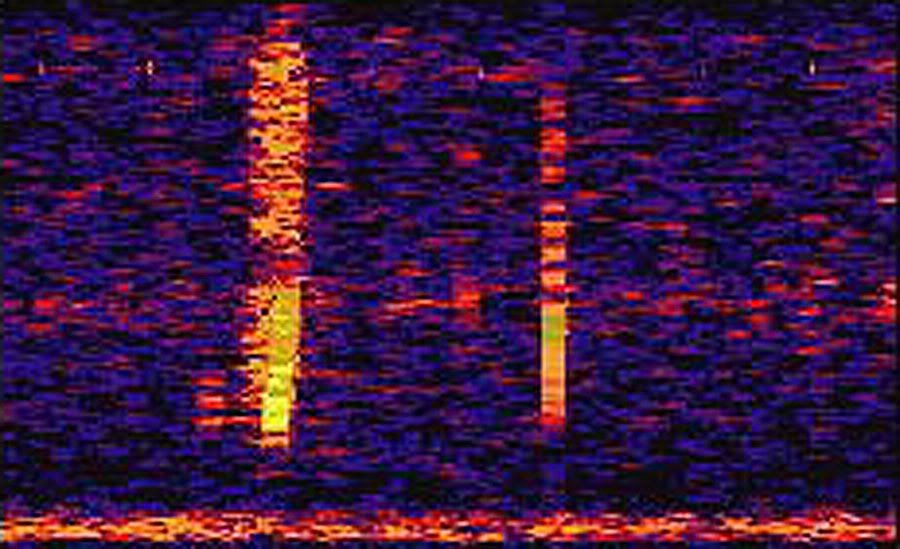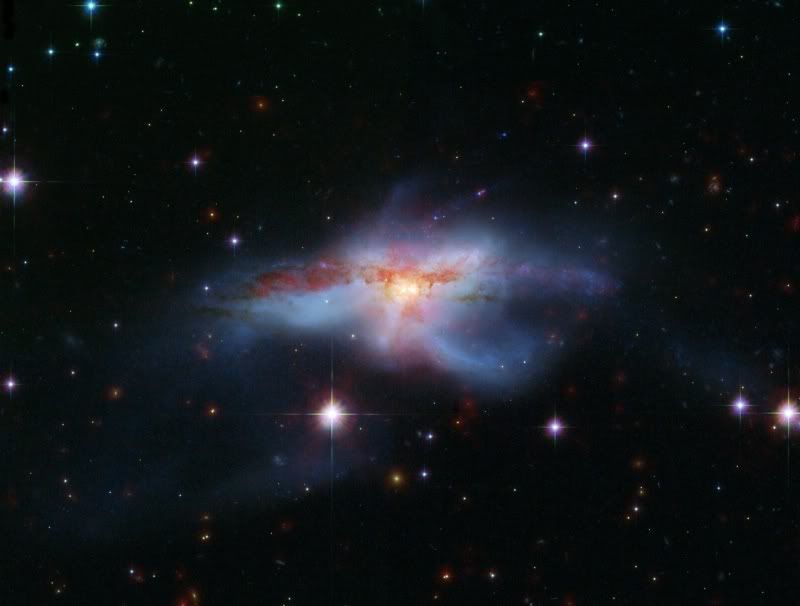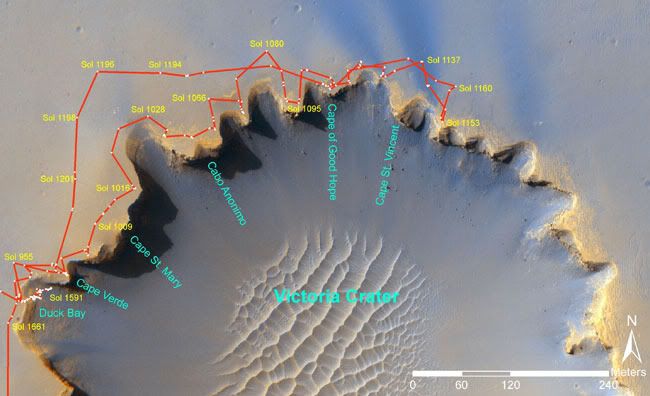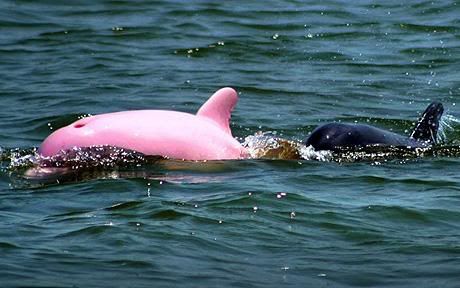
Over 16,528,775 people are on fubar.
What are you waiting for?


Explanation: What created this strange sound in Earth's Pacific Ocean? Pictured above is a visual representation of a loud and unusual sound, dubbed a Bloop, captured by deep sea microphones in 1997. In the above graph, time is shown on the horizontal axis, deep pitch is shown on the vertical axis, and brightness designates loudness. Although Bloops are some of the loudest sounds of any type ever recorded in Earth's oceans, their origin remains unknown. The Bloop sound was placed as occurring several times off the southern coast of South America and was audible 5,000 kilometers away. Although the sound has similarities to those vocalized by living organisms, not even a blue whale is large enough to croon this loud. The sounds point to the intriguing hypothesis that even larger life forms lurk in the unexplored darkness of Earth's deep oceans. A less imagination-inspiring possibility, however, is that the sounds resulted from some sort of iceberg calving. No furtherBloops have been heard since 1997, although other loud and unexplained sounds have been recorded.
Though coordinating eight separate arms might seem a tricky task for an octopus brain, what’s really demanding is controlling the arms’ flexible, infinitely variable movements. Now researchers have figured out part of their secret.
Unlike us, specific regions of an octopus’ motor cortex don’t correspond to specific parts of its body. Instead, each region controls different parts at different times. Their motor neural network seems as flexible as their bodies — a phenomenon that expands the range of neurophysiological possibility, and could refine the design of arm-flexing robots.
“We think, because of the complexity of the octopus body and its variability, that it has another way of organizing its control system. That’s what we find in this study,” said Benny Hochner, a Hebrew University of Jerusalem neurobiologist and author of research published Thursday in Current Biology.
“It’s suited to a structure with many more degrees of freedom than our own body, which is constructed around a segmented skeletal structure with few degrees of freedom.”
How octopuses control their arms has been a focus of Hochner’s work for more than a decade. In earlier studies, he helped show that seemingly complex movements are actually combinations of individually simple motions. Hochner also found that many of the movements are guided peripherally, rather than by the brain, as if each arm had its own spinal cord.
An octopus brain sends a general prompt, and the arm computes the specifics: It’s much simpler than running all those calculations in the brain itself. And all this is especially interesting to roboticists who want to build machines with flexible appendages, ideal for rescue bots working in disaster areas or surgical machines weaving through a body.
“The idea is to draw inspiration from biology to answer the question of how to generate movement in a flexible structure, and how to control this with the nervous system,” said Hochner.
In the latest study Hochner’s team ran electrical currents through wires inserted into in the animals’ brains, measured the resulting movements, and then dissected the sacrificed animals to see exactly what the electrodes had stimulated.
They found yet another example of modular, highly efficient design: Each site proved capable of generating different movements, in different arms, with movements becoming more complex as the current increased. In humans, most body parts are controlled at a single, unchanging location.
“The networks are embedded in one another. The system is remodeled according to stimulation. It’s more dynamic, rather than strictly organized,” said Hochner.
Hochner suspects that other neurological programs, stored elsewhere in the octopuses’ bodies — perhaps at the base of each arm — act as gates, blocking signals from the brain or allowing them to pass.
That possibility is especially intriguing to Cecilia Laschi, a biomedical engineer at Italy’s Sant’Anna School of Advanced Studies and member of the Octopus Project, a group of researchers building octopus-inspired soft-bodied robots.
“This is very important for robotics. If you build a robot with many degrees of freedom, it becomes very difficult to control.” said Laschi, who was not involved in the study. “We know that some movements are controlled peripherally, some parameters are set by the brain, and we will do the same thing in our robots.”
But whereas roboticists building humanoid forms can already try to mimic the human brain’s layout in their computing, Laschi said that “with the octopus, we’re not at that level — yet.”
Citation: “Nonsomatotopic Organization of the Higher Motor Centers in Octopus.” By Letitzia Zullo, German Sumbre, Claudio Agnisola, Tamar Flash and Binyamin Hochner. Current Biology, Volume 19 Issue 18, September 17, 2009.
Image: Noel Feans/Flickr
Good news today from The Wildlife Conservation Society. They've announced the discovery of a new monkey from Brazil.
The image shows an artist's rendering of "Mura's saddleback tamarin" -- the newly discovered monkey found in a remote area of the Amazon. (Credit: Stephen Nash)
At a press conference today, a handout was issued with the following information:
<<The monkey is related to saddleback tamarins, which include several species of monkeys known for their distinctively marked backs. The newly described distinct subspecies was first seen by scientists on a 2007 expedition into the state of Amazonas in northwestern Brazil.
The discovery was published in the June online edition of the International Journal of Primatology. Authors of the study include Fabio Röhe of the Wildlife Conservation Society, José de Sousa e Silva Jr. of Museu Paraense Emílio Goeldi, Ricardo Sampaio of the Instituto Nacional de Parquisas de Amaozônia, and Anthony B. Rylands of Conservation International.
Researchers have dubbed the monkey Mura's saddleback tamarin (saguinus fuscicollis mura) named after the Mura Indians, the ethnic group of Amerindians of the Purus and Madeira river basins where the monkey occurs. Historically this tribe was spread through the largest territory of any of the Amazonian Indigenous peoples, extending from the Peruvian frontier today (Rio Yavari) east to the Rio Trombetas.
The monkey is mostly gray and dark brown in color, with a distinctly mottled "saddle." It weighs 213 grams (less than ¾ of a pound) and is 240 millimeters (9 inches tall) with a 320 millimeter (12.6 inch) tail.
"The Wildlife Conservation Society is extremely proud to be part of this exciting discovery in the Amazon," said Dr. Avecita Chicchon, Director of WCS's Latin America Programs. "We hope that the discovery will draw attention to conservation in this very fragile but biodiverse region."
According to the study's authors, the monkey is threatened by several planned development projects in the region, particularly a major highway cutting through the Amazon that is currently being paved. Conservationists fear the highway could fuel wider deforestation in the Amazon over the next two decades. Other threats to the region include a proposed gas pipeline and two hydroelectric dams currently in the beginning stages of construction.
"This newly described monkey shows that even today there are still major wildlife discoveries to be made," said the study's lead author, Fabio Röhe of the Wildlife Conservation Society. "This discovery should serve as a wake-up call that there is still so much to learn from the world's wild places, yet humans continue to threaten these areas with destruction."
The Wildlife Conservation Society helped establish the Mamirauá, Amanã, and Piagaçu-Purus Sustainable Development Reserves in Brazil, which represent some of the largest protected blocks of rainforest on the planet.
WCS researchers have discovered several new monkey species in recent years: the Arunachal macaque, discovered in India in late 2004; and the Madidi monkey and Kipunji discovered in Bolivia and Tanzania respectively in 2005. In 2008, Jean Boubli, who now works for WCS, discovered a new species of uakari monkey in the Amazon and named it after noted WCS primatologist José Márcio Ayres.
WCS's Brazil Program would like to acknowledge the GEOMA project at the Ministry of Science and Technology of Brazil, for its support in the project that led to the discovery of the monkey.>>



April 3, 2009 -- Some 80 percent of Arctic ice may disappear in 30 years, not 90 as scientists had previously estimated, according to a new study on the impact of global warming.
"The amount of the Arctic Ocean covered by ice at the end of summer by then could be only about 1 million square kilometers, or about 620,000 square miles," said researchers who authored the study published Thursday.
"That's compared to today's ice extent of 4.6 million square kilometers, or 2.8 million square miles," they added, warning the development "raises the question of ecosystem upheaval."
The scientists made their projections based on models that took accounted for changes in Arctic ice, which saw "dramatic declines" at the end of summer in 2007 and 2008, when the ice surface dropped to 4.3 and 4.6 million square kilometers (1.7 and 1.8 million square miles), respectively.
The models pointed to a "nearly ice-free" Arctic in just 32 years, with some of the models making the same prediction for 11 years from now.
Related Content:
"In recent years, the combination of unusual warm temperatures from natural causes and the global warming signal have worked together to provide an earlier summer sea-ice loss than was predicted," said James Overland of the National Oceanic and Atmospheric Administration (NOAA).
Overland and co-author Muyin Wang of the University of Washington said earlier models had predicted the event would not take place before the end of the 21st century.
Maps illustrating Overland and Wang's models showed a nearly ice-free Arctic Ocean, although some ice would remain along northern Canada and Greenland, where powerful winds make for very thick layers of ice.
The researchers noted one benefit of less ice in the Arctic: "a boon for shipping and for extracting minerals and oil from the seabed."
 The world's only pink Bottlenose dolphin which was discovered in an inland lake in Louisiana, USA, has become such an attraction that conservationists have warned tourists to leave it alone.
Last Updated: 5:44PM GMT 05 Mar 2009
Pinky the rare albino dolphin has been spotted in Lake Calcasieu in Louisiana, USA Photo: CATERS NEWS
Charter boat captain Erik Rue, 42, photographed the animal, which is actually an albino, when he began studying it after the mammal first surfaced in Lake Calcasieu, an inland saltwater estuary, north of the Gulf of Mexico in southwestern USA.
Capt Rue originally saw the dolphin, which also has reddish eyes, swimming with a pod of four other dolphins, with one appearing to be its mother which never left its side.
He said: "I just happened to see a little pod of dolphins, and I noticed one that was a little lighter.
"It was absolutely stunningly pink.
"I had never seen anything like it. It's the same color throughout the whole body and it looks like it just came out of a paint booth.
"The dolphin appears to be healthy and normal other than its coloration, which is quite beautiful and stunningly pink.
"The mammal is entirely pink from tip to tail and has reddish eyes indicating its albinism. The skin appears smooth, glossy pink and without flaws.
"I have personally spotted the pink dolphin 40 to 50 times in the time since the original sighting as it has apparently taken up residence with its family in the Calcasieu ship channel.
"As time has passed the young mammal has grown and sometimes ventures away from its mother to feed and play but always remains in the vicinity of the pod.
"Surprisingly, it does not appear to be drastically affected by the environment or sunlight as might be expected considering its condition, although it tends to remain below the surface a little more than the others in the pod."
Regina Asmutis-Silvia, senior biologist with the Whale and Dolphin Conservation Society, said: "I have never seen a dolphin coloured in this way in all my career.
"It is a truly beautiful dolphin but people should be careful, as with any dolphins, to respect it - observe from a distance, limit their time watching, don't chase or harass it
"While this animal looks pink, it is an albino which you can notice in the pink eyes.
"Albinism is a genetic trait and it unclear as to the type of albinism this animal inherited."
A close relation of dolphins, the Amazon River Botos, called pink dolphins, live in South America in the Amazon.
The world's only pink Bottlenose dolphin which was discovered in an inland lake in Louisiana, USA, has become such an attraction that conservationists have warned tourists to leave it alone.
Last Updated: 5:44PM GMT 05 Mar 2009
Pinky the rare albino dolphin has been spotted in Lake Calcasieu in Louisiana, USA Photo: CATERS NEWS
Charter boat captain Erik Rue, 42, photographed the animal, which is actually an albino, when he began studying it after the mammal first surfaced in Lake Calcasieu, an inland saltwater estuary, north of the Gulf of Mexico in southwestern USA.
Capt Rue originally saw the dolphin, which also has reddish eyes, swimming with a pod of four other dolphins, with one appearing to be its mother which never left its side.
He said: "I just happened to see a little pod of dolphins, and I noticed one that was a little lighter.
"It was absolutely stunningly pink.
"I had never seen anything like it. It's the same color throughout the whole body and it looks like it just came out of a paint booth.
"The dolphin appears to be healthy and normal other than its coloration, which is quite beautiful and stunningly pink.
"The mammal is entirely pink from tip to tail and has reddish eyes indicating its albinism. The skin appears smooth, glossy pink and without flaws.
"I have personally spotted the pink dolphin 40 to 50 times in the time since the original sighting as it has apparently taken up residence with its family in the Calcasieu ship channel.
"As time has passed the young mammal has grown and sometimes ventures away from its mother to feed and play but always remains in the vicinity of the pod.
"Surprisingly, it does not appear to be drastically affected by the environment or sunlight as might be expected considering its condition, although it tends to remain below the surface a little more than the others in the pod."
Regina Asmutis-Silvia, senior biologist with the Whale and Dolphin Conservation Society, said: "I have never seen a dolphin coloured in this way in all my career.
"It is a truly beautiful dolphin but people should be careful, as with any dolphins, to respect it - observe from a distance, limit their time watching, don't chase or harass it
"While this animal looks pink, it is an albino which you can notice in the pink eyes.
"Albinism is a genetic trait and it unclear as to the type of albinism this animal inherited."
A close relation of dolphins, the Amazon River Botos, called pink dolphins, live in South America in the Amazon.